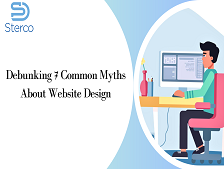A good website is your trump card to make a solid initial impression on target audiences and users. In this era of rapidly decreasing attention spans among users, it is crucial to design your company website to instantly catch the eye of visitors and hook them. Besides displaying the features of your products and services, the website should create a good impression of your brand and the values that it espouses.
An effective website design should not only make a good first impression but also leave an indelible imprint on your visitors. Creating an optimized design layout will provide them with a better user experience and give you a distinct advantage over your competitors.
While it is essential to invest in good-quality design to create a website that is visually appealing and effective, it is also necessary to debunk some common web design myths. Here we will clear the misconceptions around common web design myths that will help you get your design right.
Myth 1: A Responsive Web Design is Not Important
In this digital world, where websites are accessed across multiple devices, businesses cannot underestimate the importance of a responsive design. In addition to desktops, responsive designs ensure that websites load fast on mobile phones, tablets, and laptops with varying screen sizes and display information properly. By ignoring the need for a responsive website design, you will be subjecting your visitors to a poor user experience, which can result in lower search engine rankings and loss of opportunities.
Myth 2: Focus on Aesthetics More Than Function
A well-designed website is a potent combination of good aesthetics and smooth functionality. So, focusing solely on the visual aspects of the website is a big mistake. Of course, you need to create a visually attractive website, but as a business owner, you need to consider several other factors such as functionality, responsiveness, user experience, accessibility, quality content, and sound SEO practices. Design your website by focusing on your business objectives and how you want your customers to benefit.
Myth 3: Designing Is a One-Time Job
Designing a website is not a one-time activity. Like everything in the digital realm, the parameters that govern website design are also fluid, and by ignoring them, it is easy to become irrelevant. Businesses and website owners need to stay on top of constantly shifting landscapes and consider evolving user preferences, newer design trends, updated search engine requirements, and other technological advancements. Moreover, websites need routine maintenance and updates to boost optimal site performance.
Myth 4: Home Page Matters the Most
Often, website owners try to showcase all their offerings on the homepage, as they feel that visitors will not take the time to browse through multiple pages. However, this is a completely wrong notion and will most certainly backfire. When visitors land on your homepage they would prefer to see a clean, uncluttered layout, without an information overload. Design your homepage with minimal content, and provide only essential information with proper links to additional details on dedicated pages. Keep in mind that visitors can land on any page on your website through proper external links. Consequently, make sure that all your pages are well-designed and optimized. This will ensure higher click-throughs, lower bounce rates, and enhanced customer satisfaction levels.
Myth 5: Website Design and SEO are Unconnected
Nothing is further from the truth! Website design and SEO are highly dependent on each other. Core SEO requirements such as robust site architecture, responsiveness, mobile-friendliness, and semantic markup rely on design structure to be effective. Experienced website design agencies factor in the best SEO practices while designing websites to ensure their enhanced online visibility and search rankings.
Myth 6: More Features Means More Customers
Website functions and features improve performance. But too many of them can ruin the user experience. A corporate website is known for its aesthetics and authenticity. Businesses need to keep in mind that their websites will only look organized and clean if it has the right elements. Implementing more than the required number of features may make navigation complex and confusing. So, you must always focus on adding only relevant features that align with the customer’s needs.
Myth 7: Designing a website is Expensive
Building a website with the right design elements will surely cost money. But it does not have to burn a hole in your pocket. The key to building a website that stays within a budget is to partner with a reputable website designing company that will advise you on the best possible tools and technologies that you can leverage to design a website that meets your business goals. They will also use their experience and expertise to deploy their best resources to ensure that you get a robust, aesthetic, functional, optimized, and well-maintained website.
Conclusion
Now that you have learned about these design myths, you can easily avoid making the same mistakes that other website owners often fall prey to. You deserve a website that you can be proud of, that fulfills your business goals and helps establish your brand with your customers. Make an appointment with a leading website design and development company today to realize your aspirations.

